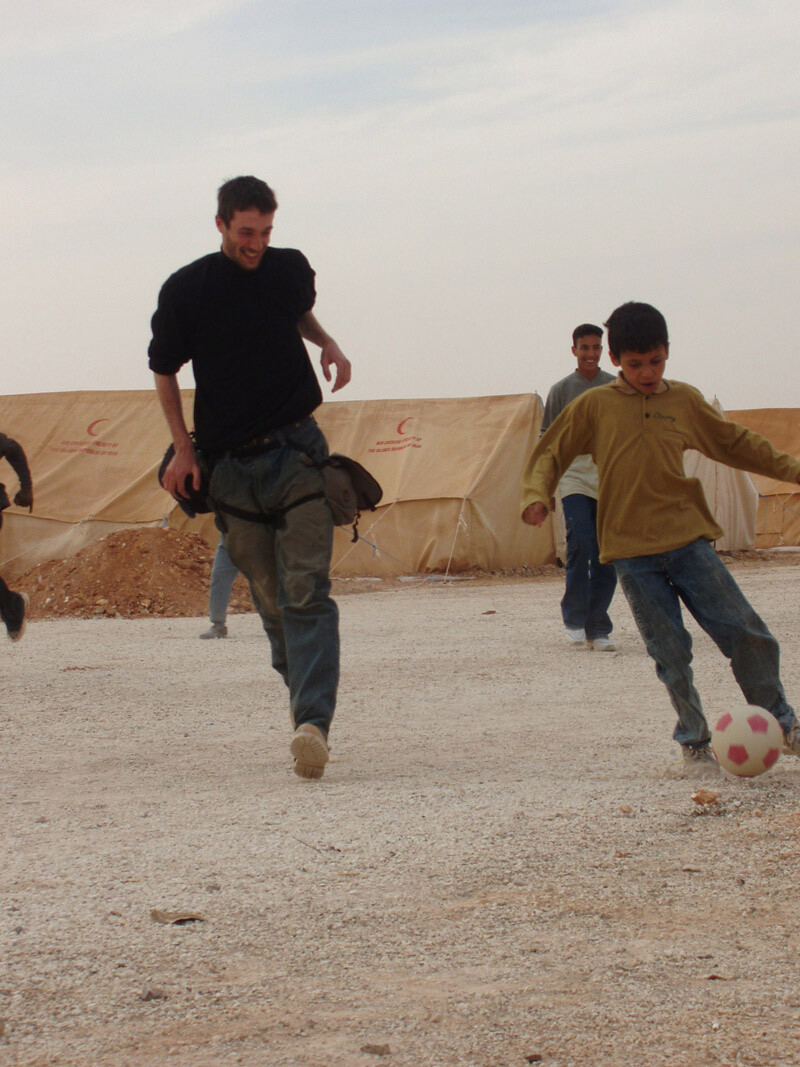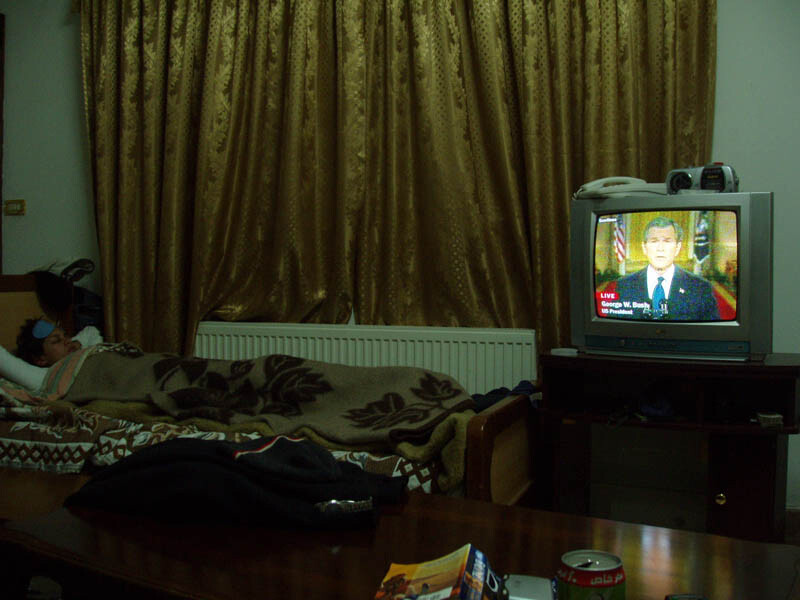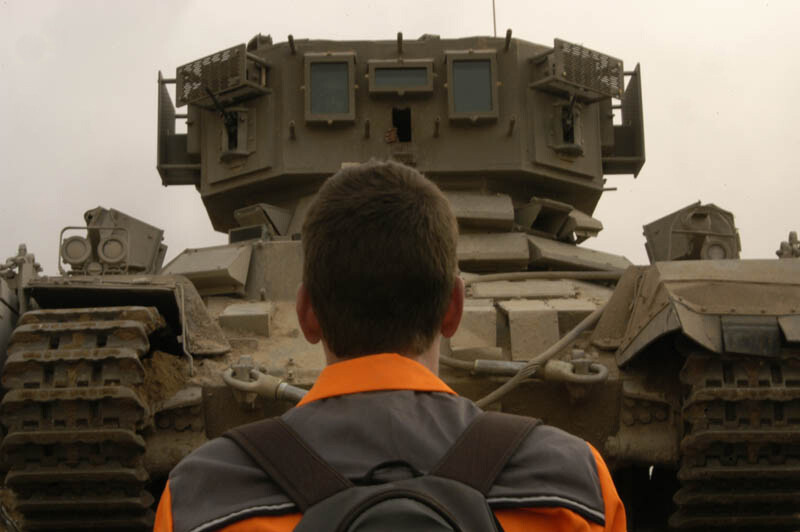The Electronic Intifada 11 June 2012

Tom Hurndall at al-Rweished refugee camp, Jordan, 30 March 2003.
In 2003, photography student Tom Hurndall joined first the Human Shields project in Iraq and later the International Solidarity Movement in Palestine. On 11 April that year, while rescuing two Palestinian children from Israeli gunfire in Rafah, Gaza, he was shot in the head by Israeli army sniper Taysir Hayb.
Hurndall was eventually transferred to a British hospital where, nine months later, he died from the wound. He was 22 years old.
Tom Hurndall was clearly murdered. The soldier used a high velocity bullet shot from a rifle mounted with a telescopic sight, and had reportedly won an award for his marksmanship. After a long campaign by the Hurndall family, in 2005 Hayb was sentenced to eight years in jail by an Israeli court. But he was released early in 2010 (“Early release of Tom Hurndall’s killer symptom of wider Israeli crimes,” International Solidarity Movement, 20 July 2010).
A new book, The Only House Left Standing: The Middle East Journals of Tom Hurndall, is a collection of Hurndall’s work and includes photographs taken just a few hours before he was shot.
Beautiful design
The photography here is accompanied by entries from Hurndall’s diary, emails he sent back home and articles he wrote in a student magazine. There are photos from Iraq and Jordan, but half of the book is dedicated to his Gaza work. This high-quality glossy book has been lovingly curated and put together, and judging from the acknowledgments page, his family, friends and supporters even stumped up the money. The design of the book is beautiful, even though the subject matter is often brutal and stark. It is an almost-macabre artifact.
My unease came from some of the diary entries, in which Hurndall seems to have foresight of his own death. Mostly, this is down to is the sort of gallows humor generated in extreme situations of war and danger such as when he joked in an email about how he intended to go to Rafah and stay “until my money runs out or I’m shot” (126). But at times it is prescient in an almost disturbing way.
What drove Hurndall? A diary entry accompanying the frontispiece explains: “What do I want from this life? … I want to be proud. I want something more. I want to look up to myself and when I die I want to be smiling about the things I’ve done, not crying for what I haven’t.”
But why Palestine? The book opens with photos from the famous 15 February 2003 demonstration in London. A crowd of approximately one million marched against the Anglo-American invasion of Iraq that was then looming. Tom briefly joined the Human Shields convoy to Iraq. He then went to Amman, Jordan, before volunteering for ten days at a camp just across the border to house refugees fleeing the American and British bombs raining down on Iraq. At the end of this section, we get a strong clue as to why his fate led to Palestine.
An unnamed five-year-old girl with searing eyes stares out from the page. She had fled Iraq with her family: “Most of the children probably still think they will be going home soon. She won’t be … her parents were Palestinian … They can’t even go back to Palestine, because Israel won’t let them” (106). The next day Hurndall arrived in Jerusalem.

“We watched avidly at 3am last night as Bush gave his ultimatum to Baghdad,” Tom Hurndall wrote at an Amman hotel, 19 March 2003.

An ISM activist confronts an Israeli armoured vehicle during an attempted home demolition in Rafah, 6 April 2003.
Tragic climax
It is also clear that he was strongly affected by the death of Rachel Corrie, another ISM volunteer murdered by Israel, not long before Hurndall. A diary entry wonders how many people even heard the news, or how many “just counted it as another death, just another number, maybe made slightly more personal by a realization that she was a person by her age and nationality” (124). He then rebels against this, by graphically imagining what she must have experienced as her body was crushed to death by the giant Israeli bulldozer that ran her over.
The climax of the book is a tragic description of Tom’s death written by the local Palestinian ISM coordinator at the time, followed by a harrowing photo taken immediately after his shooting. The combination of the two is simply tear-jerking.
Some of the diary entries here are extremely personal, and the family has been very brave to publish them. The project is all the better for them and the insight they give into Hurndall’s photography. But the book is also the final fulfillment of a project Hurndall himself refers to in one email home from Iraq (96). In the acknowledgements, his parents also write that “Tom’s book has now been published, as close to his intentions as could be.” Therefore I must devote a word to assessing Hurndall’s work on its own terms.
He was no doubt a talented photographer. But at times he also displays a certain ignorance of Palestinian life and politics, despite claiming to have studied the region. In a photograph emailed to family and friends, he describes “two Hamas members” in a photo which shows masked Palestinian fighters in Gaza City — but in fact they are clearly wearing the red star logo of the Democratic Front for the Liberation of Palestine. In another, fighters wearing the logo of the Popular Resistance Committees are described as “Islamic Jihad” (192-3).
Learning process
Diary entries and private correspondence are not usually held up to such public scrutiny. Like many of us who arrive in Palestine from the West, he was going through a learning process, and this book is an insight into that. And unlike most reporters from the West (comfortably living in their Jerusalem hotels waiting for the next Israeli government press release), Hurndall had the bravery to live under Israeli fire, standing alongside the Palestinian people.
Hurndall had been in Palestine for less than ten days before his life was ended by the murderers of the Israeli army. If it had not been for them, his work would no doubt have developed and grown. Like thousands of Palestinians, who do not have books devoted to their final works, his life was brutally cut short.
All photographs courtesy of Trolley Books.
Asa Winstanley is a journalist from London who has lived and reported from occupied Palestine. His website is www.winstanleys.org.






Comments
I think the criticism of
Permalink Joe replied on
I think the criticism of "displaying a certain ignorance" is uncalled for and sounds a bit arrogant from the writer. First, it doesn't have a place in the entire piece and stands out as a critique for the sake of critique. Second, this is a 22 year old who was learning (as the writer rightfully claims). It can be forgiven by using less stern and arrogant language like "ignorance." Perhaps Hurndall knew the fighters were in fact Hamas wearing face masks from their father's DFLP closet. Regardless, just sounds unnecessary in an otherwise nice article you have written. Of course, it doesn't help when you call ignorant a dead person who has no possibility to respond.
A Poignant story and life and
Permalink Fathima replied on
A Poignant story and life and a must read for all those who care about human rights and Palestine. Thanks to the Hurndall family for sharing their son's life with the readers.
Who killed Hurndall !
Permalink dr. abraham Weizfeld replied on
The review here states, "he was shot in the head by Israeli army sniper Taysir Hayb." although the army sniper is not Israeli, he is Druze-Israeli, which is a different story. It is not necessary to use the generalization 'Israeli' without qualification, as is a common practice. The precise facts are needed to make some advance in the analysis of the conflict. The Israel State soldiers are not Israeli per se, they are Zionists and not Jewish or 'Jews'. The difference -- of course -- between Jewish people and Zionists is evident if one considers that 2/3rds of the Jewish people have chosen not to live in Palestine. Again, precision is crucial. Tom was a serious person that I worked with in Balata camp in 2003. At the end of the two-weeks work there in removing Zionist barriers to the market street, I asked him what he intended to do next. He replied that he was going to Rafah. I said Rafah, that's dangerous! He replied, "I know".
And unlike most reporters
Permalink Manuel replied on
And unlike most reporters from the West (comfortably living in their Jerusalem hotels waiting for the next Israeli government press release)
The Israel State soldiers are
Permalink Manuel replied on
The Israel State soldiers are not Israeli per se, they are Zionists and not Jewish or 'Jews'. The difference -- of course -- between Jewish people and Zionists is evident if one considers that 2/3rds of the Jewish people have chosen not to live in Palestine. Again, precision is crucial.